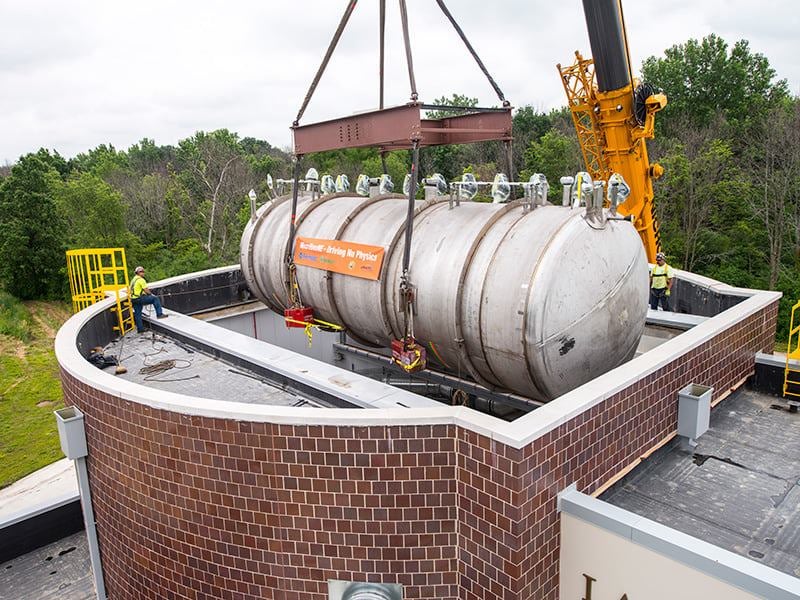
Building Useful Gadgets
Necessity is the mother of invention, and nowhere does that aphorism apply more than in the realm of humans and their physical needs.
That need has inspired Paul Hansma, a UC Santa Barbara biophysicist, to devote decades of his career to developing instruments that can advance medicine in the diagnosis and treatment of some of the most debilitating conditions, thereby improving human health.
“What I find most fascinating and fun about inventing is working with an interdisciplinary team to create really helpful gadgets,” Hansma said.
For his work, which has resulted in fundamental insights into and inventions for conditions such as bone injuries and osteoporosis as well as chronic pain, Hansma has been selected to join the National Academy of Inventors (NAI). Hansma, according to the NAI, has “demonstrated a highly prolific spirit of innovation in creating or facilitating outstanding inventions that have made a tangible impact on the quality of life, economic development and the welfare of society.” He joins 174 other distinguished academic inventors across the country in this year’s cohort of NAI Fellows.
“I am honored to join distinguished inventors like Stephen Chu, Kumar Wrickamasinghe and Paul Alivisatos as a Fellow of the National Academy of Inventors,” Hansma said. “I am grateful to the people who nominated me and those who elected me.”
“I congratulate Paul Hansma on this significant achievement,” said Pierre Wiltzius, dean of mathematical, life and physical sciences at UC Santa Barbara. “His election to the National Academy of Inventors is well-deserved, as his work has advanced our fundamental understanding of the human body and contributed practical solutions to the way that people heal. Overall, Paul’s research is marked not only by pioneering innovation, but also by widespread impact. I am proud of his continuing contributions, and delighted for him to receive this recognition”
Joining the Department of Physics in 1972, Hansma brought to the campus his expertise in the technique of electron tunneling, a phenomenon found to be useful for a new method of imaging that would give researchers a glimpse of the atomic structure of a material. Always on the lookout for improvements to the technology, while at UCSB he co-invented Scanning Tunneling Microscopes (STMs) that could function outside the ultra-high vacuum that was required for the operation of previous STMs, allowing imaging to take place in the presence of air, and water.
Hansma then shifted his research to another form of nanoscale imaging called Atomic Force Microscopy (AFM), a technology that could work on a much larger variety of samples than STM. In particular, it could work on biological samples in water, opening the door to what has become a huge area of current biological and biomedical research: AFM of biological processes to understand things such as the mechanism of action of antimicrobial peptides. It is the highest resolution microscopy available for biological samples in water, other than that of another technology he co-invented, called Scanning Ion Conductance Microscopy (SICM). SICM is more difficult to use than AFM and so, thus far, is only used by specialists.
He collaborated with fellow physics professor Virgil Elings, who started a company, licensed Hansma’s UCSB patent and produced the world’s first commercial AFM, the Multimode.
Hansma continued to build more advanced AFMs at UCSB. Elings’ Digital Instruments (ultimately acquired by Bruker) and its spinoff Asylum Research have licensed UCSB inventions and have successfully produced advanced commercial AFMs in Santa Barbara.
It was with AFM that Hansma and his interdisciplinary collaborators in 2005 discovered a biopolymer in human bone that allows healthy bone to absorb shocks without breaking — a fundamental insight that could lead to new therapies for bone fracture.
That fundamental discovery was followed with a new device, a Reference Point Indentation instrument that can measure the hardness of bone in a patient, which can help doctors make quicker and more precise diagnoses about their patients’ fracture risk.
Today, Hansma’s research is focused on helping people overcome chronic pain, via another collaboration that involves a wide range of expertise across the UC Santa Barbara campus. He and colleagues UCSB Chancellor Henry Yang, Professor Linda Petzold, Professor Michael Miller, Franklin Ly, Destinee Cheng, Elyes Turki, Celia Vann and Tyler Santander are working to develop biofeedback devices to help people overcome chronic pain. In addition to physics, departments represented include mechanical engineering, computer science, biology and psychology. “UCSB has a distinguished history of interdisciplinary work that continues to inspire me,” Hansma said.
A Fellow of the American Physical Society (APS), the American Association for the Advancement of Science and the Institute of Physics, Hansma also is a recipient of the 2000 APS Biological Physics Prize.
NAI will conduct its Fellows Induction ceremony June 7-9, 2021 in Tampa, Florida.
The 2020 Fellow class represents 115 research universities and governmental and non-profit research institutes worldwide. They collectively hold over 4,700 issued U.S. patents. Among the 2020 class are 24 fellows of the National Academies of Sciences, Engineering, and Medicine, six members of the American Academy of Arts & Sciences, and two Nobel Laureates, as well as recipients of other honors and distinctions. Their collective body of research covers a range of scientific disciplines including biomedical engineering, computer engineering, materials science and physics.



